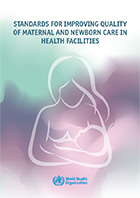
Much progress has been made during the past two decades in coverage of births in health facilities; however, reductions in maternal and neonatal mortality remain slow. With increasing numbers of births in health facilities, attention has shifted to the quality of care, as poor quality of care contributes to morbidity and mortality. The period around childbirth is the most critical for saving the maximum number of maternal and newborn lives and preventing stillbirths.
The framework in this resource contains eight standards that align with the domains of quality of care that should be assessed, improved and monitored within the health system. The eight standards are: (i) evidence-based practices for routine care and management of complications; (ii) actionable information systems; (iii) functioning referral systems; (iv) effective communication; (v) respect and preservation of dignity; (vi) emotional support; (vii) competent, and motivated personnel; and, (viii) availability of essential physical resources. These standards further inform quality statements and measures, as well as direction on an implementation approach.
The resource focuses on the standards of care, competence, services and physical resources necessary to ensure that maternal and neonatal health conditions are appropriately assessed, managed or referred within a functioning health system in order to provide the optimal care. The standards of care and quality measures should be adapted to the local context to ensure their applicability and to obtain the desired outcomes for mothers and newborns.
The framework, standards of care and quality measures are intended primarily for use by policy-makers, programme managers, health planners at national, sub-national, district and facility levels, maternal and newborn health care professionals, and professional bodies or technical partners involved in quality of care or which advise ministries of health. They can also be used as a resource in medical training institutions.
Related Documents
Guideline: counselling of women to improve breastfeeding practices
